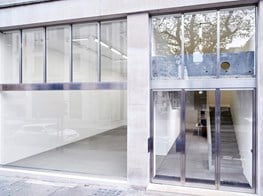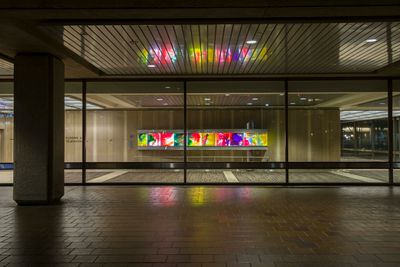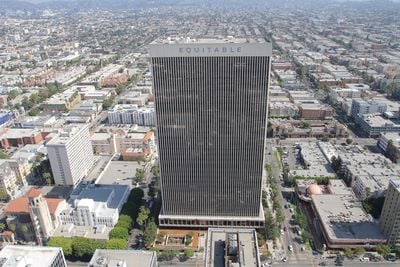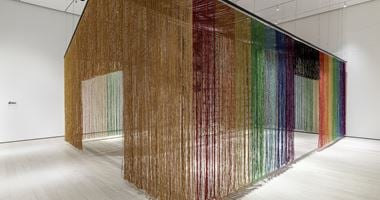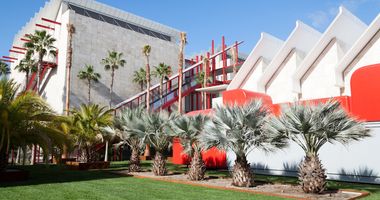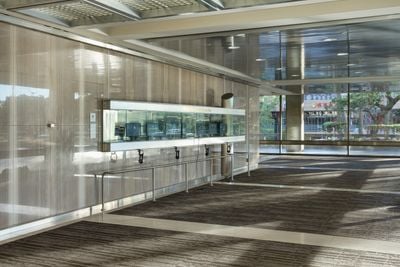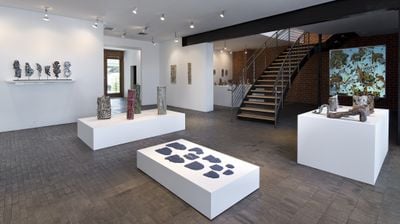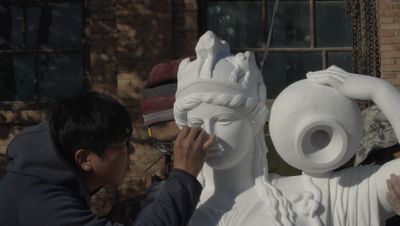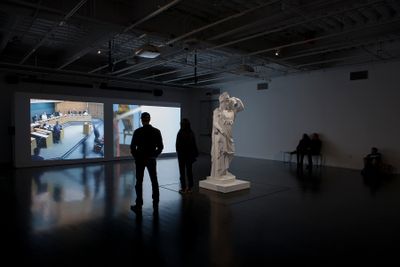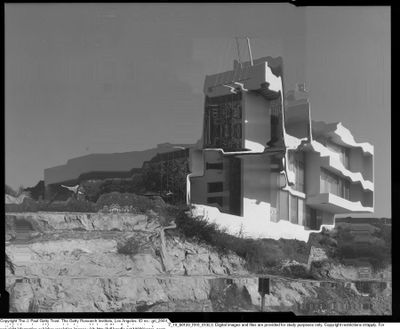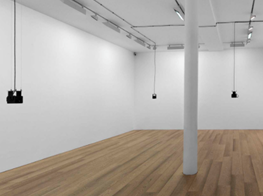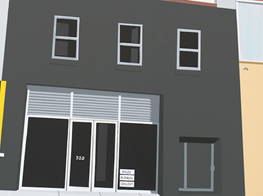Equitable Vitrines: Public Art and Contested Space
Ellie Lee and Matt Connolly. Photo: Sara Pooley.

Ellie Lee and Matt Connolly. Photo: Sara Pooley.
Founded in Los Angeles in 2014 by Ellie Lee and Matt Connolly, the non-profit Equitable Vitrines responds to orthodoxy in contemporary art by producing site-specific projects in unconventional spaces. The idea for Equitable Vitrines began when Lee encountered two empty vitrines in the Equitable Life Building on Wilshire Boulevard, a Los Angeles mid-city skyscraper built in 1969 by the firm of prominent modernist architect Welton Becket.
Lee and her partner, artist Matt Connolly, negotiated with the buildings' management to transform the vitrines into public displays of contemporary art by creating a public platform for both an art and non-art world audience in the building's publicly accessible ground floor plinth. In the two years of exhibiting in the Equitable Life Building, from 2014 to 2016, artists including Battle Trance, Jennifer Moon, and Yunhee Min, and Klaus Weber presented work. Min's installation Luminaire Delirium (Equitable Life or soft machine) (2015) involved poured paint illuminated by fluorescent lights to create contrasts in form and colour, drawing on Southern California's light-saturated environment.
Good art for us is something that expresses the vastness of human potential, and/or the strangeness of being a subject stuck in a particular point in spacetime.
Will You Still Love Me: Learning to Love Yourself, It Is The Greatest Love Of All (2015) by Jennifer Moon consisted of a series of TV screens in one vitrine, transmitting live feeds of the artist's daily routine framed with famous quotes about love. The accompanying vitrine was emblazoned with text that read 'Learning to Love Yourself, It Is the Greatest Love of All', along with text, images, and photography referencing philosopher Jeremy Bentham's designs for the panopticon—a structure that allows a watchman to observe occupants without them being aware of whether or not they are being watched.
Beginning in 2017, Equitable Vitrines has expanded its programme across different institutional sites in LA County. By adapting the unique approach they implemented within the lobby of the Equitable Life Building, they have developed an experimental protocol for the realisation of public art that is grounded in research and relationship-building around a chosen site. They first tested this new approach in the City of Monterey Park, California, where they worked for nearly two years to place a sculpture by New York-based artist Wang Xu in a beloved public fountain. While Equitable Vitrines ultimately rescinded its proposal in the midst of a confrontation at a meeting of Monterey Park's City Council, they went on to produce Garden of Seasons at the Vincent Price Art Museum (8 December 2018–9 March 2019). The exhibition consisted of a monumental figurative sculpture titled Athena (2018) and a two-channel video Garden of Seasons (2018), which poetically contrasts the process by which Wang made his sculpture and the various rhetorical acts committed and instigated by Equitable Vitrines in tandem. What results is a sensitive and provocatively ambivalent reflection on the relationship between physical objects and the various myths, both large and small, that are deployed in an attempt to render them animate.
Later this year, acclaimed artist Florian Hecker will present an installation of computer-generated sound interspersed throughout Rudolph Schindler's Fitzpatrick-Leland House in the Hollywood Hills, drawing from philosopher Jean-François Lyotard's concept of immaterials.
In this Ocula Conversation, Equitable Vitrines founders Lee and Connolly discuss site-specificity, expanded formats for exhibition-making, and the nuances of commissioning public art.
Equitable Vitrines began as a display of art in two vitrines of the Equitable Life Building in Koreatown, Los Angeles. How did this idea take hold?
Ellie Lee: My father, who is a lawyer, has had an office in the Equitable Life Building since I was little kid, so I've spent a good amount of time in the building, running through the halls while he had to work on some weekends, doing 'homework' and sunbathing on the roof while I was in high school. After graduating from USC with a degree in art, I almost immediately began working in his office as a design consultant on federal copyright cases, dealing primarily with textile designs used by his clients in the garment industry. I had always been peripherally aware of the vitrines—a rather conspicuous design element within the lobby—but it wasn't until I started working in the building that it struck me as strange that these two prominent display cases never had anything in them.
It was important for us to realise that it is possible to talk about an idea or an artwork in quite different ways to different types of people, while being entirely sincere in each case.
Matt Connolly: After doing some research, we determined that the vitrines were not part of the original plan for the building, which was designed by the well-known L.A. firm, Welton Becket Associates and completed in 1969. In fact, the lobby's current motif was established in the early 1990s, when the entire building was more or less gutted while undergoing asbestos abatement. We never determined who made the decision to install the vitrines, but we were able to track down a few tenants who had been around since the time of their installation, and by their account, the building's management had never shown any interest in using them to display anything. This points toward a theme that we have encountered repeatedly through our work, particularly in public or quasi-public spaces. Gestures toward art often satisfy the need for art, or the perceived need for art.
EL: In 2014, we approached the Equitable Life Building's management and requested access to the vitrines for the purpose of putting art in them. They were amenable, with some conditions, and we ended up producing six exhibits in the vitrines over two years. From the beginning, we felt that the negotiations we had with the building's representatives were no less important—no less a part of our overall project—than our conversations with the artists we worked with, and our built-in audience of tenants and visitors.
MC: Yes—bureaucrats, artists, and tenants—each required a different way of thinking and speaking about what art is and what it can or should do. It was important for us to realise that it is possible to talk about an idea or an artwork in quite different ways to different types of people, while being entirely sincere in each case.
EL: To add, by stepping outside of a more traditional exhibition scenario in which exhibitor, artist, and viewer share a number of assumptions about what is supposed to happen in a space where art is displayed, we found ourselves working through very foundational questions related to art as a mode of communication.
Was the intention always to extend out of the Equitable Life Building to site-specific commissions engaging communities around Los Angeles County?
EL: By the time that our tenure in the lobby came to a close, we felt that we had developed a method of working that was novel, productive, and that manifested our deepest concerns about art.
MC: We didn't want to stop; Equitable Vitrines had come to reflect our strengths, and yes as Ellie said, our concerns—it provided us with an opportunity to develop our faculties. So, we put a lot of thought into how we might go about extrapolating the methodology we developed in the lobby to other places in L.A. County. We asked ourselves: what have we been doing? Conversing with an ambivalent bureaucratic body toward the realisation of projects by high-level artists in an idiosyncratic environment with a deliberate orientation toward an audience that lies outside of what we might refer to as 'the art world'.
From what we could tell, most art that arrives in the municipal realm is the product of compromise and concessions. We thought that the model we worked out at the Equitable Life Building—where we approach 'the management' with a fully conceptualised, fully funded idea and proceed to negotiate for access—could be a way of resolving this dilemma.
EL: We also decided that what we were doing could be referred to as 'public art'.
MC: Yes, 'public art'—an amorphous term used to characterise a very unspecific set of objects and situations. As we thought deeper into it, we came to see a lot of public art as being united in the fact that it isn't good art. Good art for us is something that expresses the vastness of human potential, and/or the strangeness of being a subject stuck in a particular point in spacetime. A lot of public art that we looked at and thought about more clearly reflected the structural limitations surrounding its realisation.
EL: Art we consider successful is normally the product of a singular vision, which is not to say that it necessarily comes from an individual. From what we could tell, most art that arrives in the municipal realm is the product of compromise and concessions. We thought that the model we worked out at the Equitable Life Building—where we approach 'the management' with a fully conceptualised, fully funded idea and proceed to negotiate for access—could be a way of resolving this dilemma.
Is this thinking what prompted you to start the Wang Xu project in Monterey Park?
MC: Yes, the Monterey Park project was our first attempt at utilising this unconventional approach to the realisation of municipal artworks. In 2016, around the time we concluded our programming at the Equitable Life Building, we were driving around Monterey Park, a city in the San Gabriel Valley east of Los Angeles, and happened upon Heritage Falls Park, a grassy hillside bisected by a picturesque fountain with a niche at its source. The niche housed a marble statue. We decided that the park would make a good site for our next project.
As was the case at the Equitable Life Building, our first step was to learn about the history of the site. We spent a couple of months conducting research and learned that the park was originally intended to be the centrepiece of a whites-only real estate development that was never built, due to the onset of the Great Depression. The niche had originally housed a classically styled marble statue that was installed by the developer, supposedly in honour of his Greek heritage. While the statue was universally referred to as 'Athena', archival photos show an anonymous female figure holding a Grecian urn, which is to say that the statue did not bear any of the signifiers traditionally associated with the Goddess Athena. 'Athena' disappeared under mysterious circumstances shortly after plans for the development were scrapped, and it wasn't until 2005 that the Monterey Park Historical Society installed a replacement, also referred to as 'Athena', which was actually a marble representation of Flora, a minor Roman goddess that they imported from China, where it had been produced.
EL: We invited Wang Xu to collaborate on a proposal for public art at Heritage Falls Park. Xu was involved in an ongoing project that addressed the commercial sculpture industry in China with great sensitivity and complexity, so he seemed like a natural partner in this project, which we saw as a way of highlighting the fascinating, layered history of Heritage Falls Park.
MC: And of Monterey Park itself.
We were disappointed to have had to abandon our plan for an intervention at Heritage Falls Park, but proud to have initiated what amounted to a three-and-a-half hour televised public debate on representation, authority, and the meaning of art in the public sphere.
EL: Yes, of Monterey Park itself, which has been referred to as 'the first suburban Chinatown' and has a remarkable though somewhat fraught history of diversity. After working with Xu to develop a proposal, we approached the City's Parks and Recreation commission during a public meeting. One commissioner was very enthusiastic about the project and explained that if we were able to demonstrate widespread community support for the project, the commission would recommend that the City Council take up or proposal for consideration. That same commissioner connected us with some of his contacts in Monterey Park.
MC: Including his pastor, a local schoolteacher, some other local officials...
EL: We spoke with them about the project, then they connected us with their friends and contacts.
MC: We spent about a year taking meetings with residents.
EL: With demonstrable community support, we brought a revised proposal to the Parks and Recreation commission, which was unanimously approved, and we were subsequently invited to present before the City Council. Unfortunately, an influential and rather conservative bloc of elderly voters banded together against the project, on the grounds that we were not residents and therefore had no right to comment on their city or its history, among many other arguments. The Council tried to persuade us to realise the project at a different, less contested public venue, but we ultimately rescinded the proposal, citing its site-specific nature. We were disappointed to have had to abandon our plan for an intervention at Heritage Falls Park, but proud to have initiated what amounted to a three-and-a-half hour televised public debate on representation, authority, and the meaning of art in the public sphere.
The project with Florian Hecker is unique for us in that it came first and foremost out of an admiration for his work—we didn't have a site or situation in mind. We initiated a conversation that established a theme for a project that called for a certain type of space, which, luckily, we were able to secure.
MC: To us it felt like success to have the project covered by the mainstream press, as opposed to Artforum or whatever. The debate was covered on the front page of Los Angeles Times, I had to wake up at 5am one morning to be interviewed on talk radio, and Matt Drudge tweeted about us. As we were briefly sucked up into the realm of 'news', the project became more real—even as our carefully composed messages, our nuanced intentions, were in a certain sense ravaged. This is what we're curious about: what happens when these art specific conversations are subjected to a stress test? What is left after the stated meaning of a work dissolves? Is our language actually doing what we think it's doing?
EL: At the end of 2018, we produced an exhibition by Wang Xu at Monterey Park's Vincent Price Art Museum, titled Garden of Seasons, that reflected on—and concluded—the process.
How did the Monterey Park project lead into your forthcoming exhibition with Florian Hecker?
MC: They're very different. We are in the early stages of another project that will relate much more closely to our work in Monterey Park, in the sense that we will be presenting a small municipality in L.A. County with an unsolicited proposal based on a year's worth of research and outreach. The project with Florian Hecker is unique for us in that it came first and foremost out of an admiration for his work—we didn't have a site or situation in mind. We initiated a conversation that established a theme for a project that called for a certain type of space, which, luckily, we were able to secure.
We're interested in getting each group in a room and trying hard to talk about what they think is going on here in a way that makes sense.
EL: Florian is producing an exhibit that will take place at Rudolf Schindler's Fitzpatrick-Leland House in the Hollywood Hills, owned by the MAK Center for Art and Architecture. Among other things, it's based on a consideration of Jean François Lyotard's concept of les immatériaux, or 'the immaterials', which Florian first came across while conducting research at the Getty the last time he was in Los Angeles, in 2003. Lyotard developed this theory while teaching at UC Irvine, and in one key text he makes reference to the landscape and architecture of Southern California to elucidate his theme.
MC: Fundamentally, our projects tend to be about scrutinising entrenched or outmoded ways of thinking and speaking about art. I am generally very skeptical of the way that theory is instrumentalised in art discourse—I think that it is often used as a stand-in for rigorous intellectual content or a gesture, like the empty vitrines. I think that such use of theory does a disservice to the real thought being committed by academics. On the other hand, I have always admired the way that theory is situated by Florian within his work. So, this project seemed like a good opportunity to further scrutinise connections between art and the academy.
EL: We'll be hosting a series of dialogues between philosophers that will coincide temporally and thematically with Florian's exhibit. The idea is not to bring in thinkers to explain the artwork, nor is it to use the artwork to illustrate philosophical concepts. We're interested in bringing these distinct populations together in a room and encouraging them to try to talk about what they think is going on here in a way that makes sense.
MC: This is how we think culture works. —[O]

